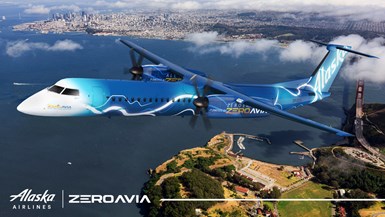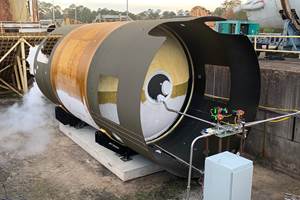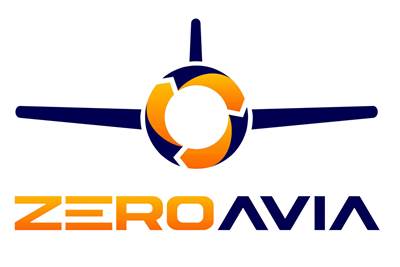ZeroAvia picks up speed on hydrogen-fueled flight with technology collaborations, planned flights
Recent partnerships with MHI RJ Aviation Group, Alaska Air Group and Royal Schiphol Group and Rotterdam The Hague Innovation Airport to advance hydrogen-electric propulsion for zero-emission capabilities.
Share
Read Next

First commercial hydrogen-electric flight between London and Rotterdam The Hague Airport expected in 2024. Photo Credit, all images: ZeroAvia
Hydrogen-electric aircraft developer ZeroAvia (Hollister, Calif., U.S.) announced several new developments in October which will take advantage of its hydrogen-electric powertrain technology — which uses hydrogen fuel cells to power electric motors — for more sustainable aircraft with lower operating costs.
So far, the company has completed more than 35 test flights of a Piper M-class six-seat aircraft using its hydrogen fuel cell powertrain, and it is working to convert a larger 19-seat Dornier 228 aircraft with its zero-emission powertrain with a first test flight expected in the coming months at Cotswold Airport in the U.K. ZeroAvia plans certification and market entry for its 19-seat powertrain by 2024, with an eye towards larger aircraft (50-80 seats) by 2026 and regional jets around 2028.
Further, ZeroAvia has also successfully ground-tested its 600-kilowatt powertrain, which is capable of flying 10-20-seat airframes 500 miles, and is moving to full-size prototype manufacturing of its 2,000-kilowatt engine for demonstrations in 2022.
One announced development includes a collaboration with CRJ Series aircraft maintenance, repair and overhaul (MRO) company MHI RJ Aviation Group (MHIRJ, Montreal, Quebec, Canada) on the design and development of hydrogen-electric propulsion for regional jets. The partnership will leverage ZeroAvia’s hydrogen fuel cell powertrain technology and MHIRJ’s aircraft design, certification and support experience to create aircraft solutions which not only have the potential to deliver new aircraft with hydrogen-electric propulsion, but also to efficiently retrofit existing aircraft in the market.
MHIRJ will be supporting ZeroAvia by providing engineering services in support of the certification of the engines to PART 33 for aircraft, as well as assisting ZeroAvia by providing advisory services evaluating the feasibility of a green retrofit program for regional aircraft.
Expanding on these developments, ZeroAvia is also joining Alaska Air Group (SeaTac, Wash., U.S.), the parent company of Alaska Airlines, for a hydrogen-electric powertrain capable of flying 76-seat regional aircraft in excess of 500 nautical miles. Alaska is also joining the list of top investors for ZeroAvia, alongside a fellow Seattle-based Amazon Climate Pledge Fund and Bill Gates’ Breakthrough Energy Ventures.
ZeroAvia to collaborate with Alaska Air Group for a hydrogen-electric powertrain capable of flying 76-seat regional aircraft in excess of 500 nautical miles.
“The aviation industry is one of the hardest industries to decarbonize; however, with this collaboration, we are one step closer to achieving our goal of making our skies emission free,” says Val Miftakhov, CEO and founder of ZeroAvia. “We are thrilled to see Alaska taking the lead to implement clean technologies into their operations and look forward to putting boots on the ground with Alaska’s team.”
Alaska and ZeroAvia engineers will work together to scale the company’s existing powertrain platform to produce the ZA2000, an engine family capable of producing between 2,000 and 5,000 kilowatts of power with a 500-mile range. The partnership will initially deploy ZeroAvia’s hydrogen-electric propulsion technology into a full-size De Havilland Q400 aircraft, previously operated by Alaska Air Group subsidiary Horizon Air Industries Inc. (Seattle, Wash., U.S.), capable of transporting 76 passengers. ZeroAvia will also work closely with aircraft regulators during this project to ensure the aircraft meets both safety and operational requirements. ZeroAvia will set up a location in the Seattle area to support this initiative.
Alaska has also secured options for up to 50 kits to begin converting its regional aircraft to hydrogen-electric power through ZeroAvia’s zero-emission powertrain, starting with the Q400 aircraft. This rollout will be supported by the ground fuel production and dispensing infrastructure from ZeroAvia and its infrastructure partners, such as Shell. Working to advance novel propulsion is one of the five parts of Alaska’s strategy to achieve net zero.
Finally, ZeroAvia expects its first commercial hydrogen-electric flight between London and Rotterdam The Hague Innovation Airport in 2024 with a 19-seater aircraft.
The aircraft, currently under development by ZeroAvia, will fly entirely on hydrogen. ZeroAvia, Royal Schiphol Group, Rotterdam The Hague Innovation Airport Foundation and the airport itself have announced a partnership to realize this ambition. Talks with airlines to agree on an operator for the planned route are underway.
Moreover, to deliver this commercial route, ZeroAvia and Royal Schiphol Group will collaborate on testing and demonstrating hydrogen supply chain refueling operations and integration with airport operations. The two companies will also focus on ensuring the pathway for commercially adopting hydrogen-electric aviation, including establishing the right regulatory framework and understanding industry and public appetite for zero-emissions flight powered by hydrogen.
ZeroAvia recently established a legal entity in the Netherlands. This will enable the company to create opportunities for commercialization and partnership with airports, airframe manufacturers and/or airlines, within the Netherlands and the wider European Union (EU).
Related Content
Collins Aerospace to lead COCOLIH2T project
Project for thermoplastic composite liquid hydrogen tanks aims for two demonstrators and TRL 4 by 2025.
Read MoreCryo-compressed hydrogen, the best solution for storage and refueling stations?
Cryomotive’s CRYOGAS solution claims the highest storage density, lowest refueling cost and widest operating range without H2 losses while using one-fifth the carbon fiber required in compressed gas tanks.
Read MoreOn the radar: Cryogenic testing of composites for future hydrogen storage
Netherlands, U.K., France, Germany and the U.S. build up test capability, look at thermoset and thermoplastic composite materials.
Read MoreHexagon Purus opens new U.S. facility to manufacture composite hydrogen tanks
CW attends the opening of Westminster, Maryland, site and shares the company’s history, vision and leading role in H2 storage systems.
Read MoreRead Next
Additional funding secures ZeroAvia hydrogen-electric engine development
Additional raise of $24.3 million in funding to accelerate developments for 50-plus seat aircraft and support commercial airline initiatives to adopt hydrogen.
Read MorePlant tour: Daher Shap’in TechCenter and composites production plant, Saint-Aignan-de-Grandlieu, France
Co-located R&D and production advance OOA thermosets, thermoplastics, welding, recycling and digital technologies for faster processing and certification of lighter, more sustainable composites.
Read MoreAll-recycled, needle-punched nonwoven CFRP slashes carbon footprint of Formula 2 seat
Dallara and Tenowo collaborate to produce a race-ready Formula 2 seat using recycled carbon fiber, reducing CO2 emissions by 97.5% compared to virgin materials.
Read More

























